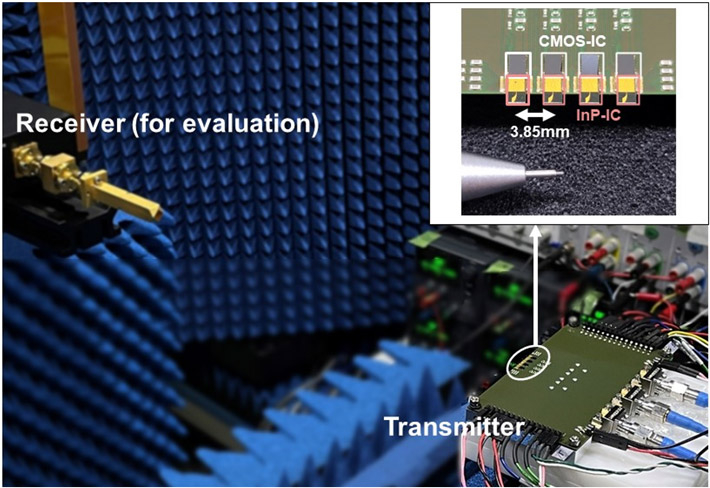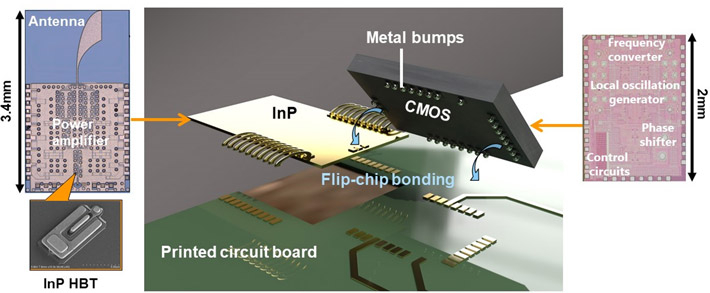NTT Corporation (Headquarters: Chiyoda-ku, Tokyo; President & CEO: Akira Shimada; "NTT") and Professor Kenichi Okada and researchers of the Department of Electrical and Electronic Engineering, School of Engineering, Tokyo Institute of Technology (Meguro-ku, Tokyo; President: Kazuya Masu; "Tokyo Tech") have developed a phased-array transmitter module for 6G wireless communication. They have succeeded in achieving the world's first beamforming wireless data transmission in the 300 GHz band. This technology will enable instantaneous ultra-high capacity data transmission to mobile receivers.
Details of this technology were presented at the 2023 IEEE MTT-S International Microwave Symposium (IMS2023) held in San Diego, California, USA, from June 11, 2023.
- Figure 1.
- (Left) Image of beamforming using phased-array wireless device. (Right) Comparison of previously reported transmission with beamforming wireless devices and this achievement.
Background of Research
In the sixth-generation wireless communications system (6G), ultra-high-speed wireless communications are expected to be achieved by utilizing the 300 GHz band. This band has the advantage of being able to use a wide frequency range. On the other hand, it faces the problem of large path loss during signal propagation through space. Beamforming technology is being studied to overcome this problem. Beamforming concentrates and directs radio energy toward the receiving device. In 5G wireless systems that use radio waves in the 28 GHz and 39 GHz bands, beamforming has been realized with CMOS integrated circuits (IC)[1]. On the other hand, CMOS-IC alone lacks sufficient output power in the 300 GHz band*. Combining CMOS-IC with III-V compound IC[2], capable of high-output power, is therefore being attempted around the world to achieve beamforming in the 300 GHz band. However, because high-output power is prevented by the large energy loss occurring inside the III-V compound IC and in the connection between the III-V compound IC and the CMOS-IC, high-speed wireless data transmission by beamforming has not been achieved until now.
- *
-
February 2021 press release "Pushed to the Limit: A CMOS-based transceiver for beyond 5G applications at 300 GHz | Tokyo Tech News"
Research Results
NTT has developed indium phosphide integrated circuit (InP-IC) chips that integrate NTT's proprietary high-output power amplifier circuit and antenna circuit. This achievement is made possible with NTT's proprietary indium phosphide-based heterojunction bipolar transistor (InP HBT[3]) technology. Tokyo Tech has succeeded in fabricating a highly scaled CMOS-IC containing frequency conversion and control circuits. NTT and Tokyo Tech have now developed a compact 4-element phased-array transmitter module[4] by mounting the aforementioned CMOS-IC and InP-IC on the same printed circuit board. With a steering range of 36 degrees,maximum data rate of 30 Gbps, and communication distance of 50 cm, this transmitter module has succeeded in achieving the world's first high-speed wireless data transmission in the 300 GHz band using beamforming (Figure 1, right).
Key Technological Points
In NTT and Tokyo Tech's achievement, the following two technologies made the beamforming and high-speed wireless data transmission possible.
Design of 300 GHz band high-output power amplifier circuit
NTT and Tokyo Tech have designed a power amplifier circuit[5] that achieves high-output power in the 300 GHz band and realized its fabrication by using NTT's proprietary InP HBT technology. For the power amplifier circuit, high output power is achieved by combining electrical power output from multiple amplifier elements using a low-loss power combiner. The circuit amplifies the signals output from the CMOS-IC and radiates the radio wave to the receiving device from the antenna packaged on the same chip. NTT and Tokyo Tech's achievement enables the delivery of high-output power to the receiving device, which is needed for high-speed data transmission (Figure 2).

Figure 2.. Photos of the newly developed 300 GHz band phased-array transmitter and the transmission experiment.
High-frequency band low-loss mounting technology
Conventionally, to connect different types of ICs for the 300 GHz band, each IC is mounted on a waveguide module[6], and the modules are connected together. However, this approach has the problem of energy loss when radio waves pass through the waveguides. NTT and Tokyo Tech's achievement overcomes this problem through flip-chip bonding[7] of the CMOS-IC and the InP-IC and connecting them using metal bumps of several ten micrometers in size. This packaging approach reduces connection loss and achieves high-output power (Figure 3).

Figure 3.. Exploded-view diagram of 300 GHz band phased-array transmitter and photo of the chip.
Future Research
Short-distance mobile communication devices are expected to be deployed in 6G networks in the future. NTT and Tokyo Tech's developed technology promises to expand these applications, such as interactive kiosks and femtocells. The developed technology demonstrated one-dimensional beamforming. NTT and Tokyo Tech are working on demonstrating two-dimensional beamforming with a 2D array and extending the communication distance by increasing the number of arrays. NTT and Tokyo Tech are also engaged in the development of receiver modules to meet the needs of 6G applications, and in the practical implementation of wireless communication with transmission capacity 10-fold greater than today's.
Terms
[1]
CMOS-IC (Complementary Metal Oxide Semiconductor-Integrated Circuit) : Integrated circuit on metal oxide semiconductor. It is used to achieve large-scale functions such as digital control. This type of circuit is often used for large-capacity transmission and reception because of its ability to handle large amounts of signals. Although device scaling has led to higher speeds, the use of compound semiconductors in CMOS-IC is superior in achieving greater speed and output power.
[2]
III-V compound IC : Semiconductor made from two or more elements belonging to group 13 (e.g., gallium Ga, indium In) and group 15 (e.g., nitrogen N, phosphorus P, arsenic As) on the periodic table. A compound semiconductor allows IC devices to handle higher frequencies because it provides greater electron mobility. Note that a III-V compound semiconductor is so-called because the periodic table's numbered groups to which its elements belong use the numbering scheme prior to the periodic table's 1990 revision.
[3]
InP HBT : Heterojunction bipolar transistor made from indium phosphide, a III-V semiconductor. This transistor enables excellent high-frequency performance and high breakdown voltage.
[4]
4-element phased-array transmitter module : Transmitter module with four transmitter elements arranged in parallel. Beamforming is achieved by controlling the phase and intensity of each element's radio wave output.
[5]
Power amplifier circuit : A circuit that amplifies an input high-frequency signal to the required power and delivers it to the antenna.
[6]
Waveguide module : A module with hollow metal tubes (waveguides) for propagating high-frequency signals.
[7]
Flip-chip bonding : A chip mounting technique in which IC chips are connected to each other or to the circuit board in a "flipped" manner via solder bumps or other bumps.
Reference
Conference : |
|
Session : |
IMS Technical Sessions |
Session Title : |
300-GHz-Band 4-Element CMOS-InP Hybrid Phased-Array Transmitter with 36° Steering Range |
. Any information published on this site will be valid in relation to Science Tokyo.






